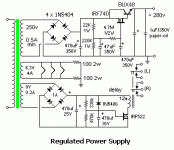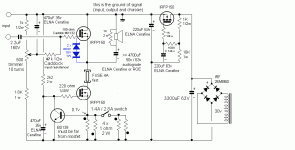Has anybody used this type of regulated PS & how good is it? I've searched under "virtual battery" but can't find anything on DIYA. Here's a short description:
I'm thinking of it for a lower voltage of up to 50V. Can it be made variable voltage output?
The supply is regulated with a Darlington hybrid (an IRF power MOSFET and a Motorola BUX48 power transistor) to implement a virtual battery (the circuit is based on a Technics design). The MOSFET/NPN pair can conduct up to 400V at 15A and will easily handle the surge currents of large power supply capacitors. The BUX48 should be heatsinked to dissipate about 6W.
I'm thinking of it for a lower voltage of up to 50V. Can it be made variable voltage output?
Attachments
Here's another version under the name Power Follower from here: http://www.audiodesignguide.com/PowerFollower/
So, this circuit adopt a little capacitor after the bridge (only 3300uF for an amplifier working with 3A bias).
This capacitor is followed by a MOSFET voltage regulator, featuring a very low frequency CR filter (220uF/100Kohm) which is based on the Virtual Battery Operation, invented by Technics (something good can be found in the consumer world, too).
Attachments
Hi jkeny,
You might want to do some searches for different types of regulators, such as Jung or Jung-Didden Super Regulator, Sulzer Regulator, Shunt Regulator, and Series Regulator. You might also want to check out this sticky thread in the Solid State forum: "Bob Cordell Interview: Power Supplies", at http://www.diyaudio.com/forums/showthread.php?s=&threadid=90728 .
You might want to do some searches for different types of regulators, such as Jung or Jung-Didden Super Regulator, Sulzer Regulator, Shunt Regulator, and Series Regulator. You might also want to check out this sticky thread in the Solid State forum: "Bob Cordell Interview: Power Supplies", at http://www.diyaudio.com/forums/showthread.php?s=&threadid=90728 .
jkeny said:searched under "virtual battery" but can't find anything
I wonder why

Seriously, this is not a regulator, it is an active filter. There is no load or line regulation, only some amount of AC reduction.
The second circuit is missing a couple of electron tubes and transformers 😀
Are you guys saying that there is no value to this technique other than
?some amount of AC reduction
the "virtual battery" (what baloney) tracks input voltage as changed by variations in line voltage and load, and takes out some AC. That may be useful under some special circumstances. In the tube days, this was done using a large choke, that's in a way what this circuit simulates.
A proper regulator gives you a known output voltage, low source resistance (as it regulates out changes due to both load and line changes), and better AC filtering, too.
A proper regulator gives you a known output voltage, low source resistance (as it regulates out changes due to both load and line changes), and better AC filtering, too.
- Status
- Not open for further replies.

